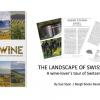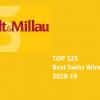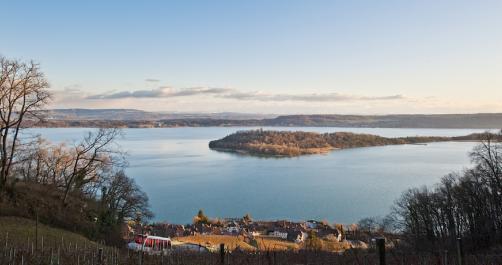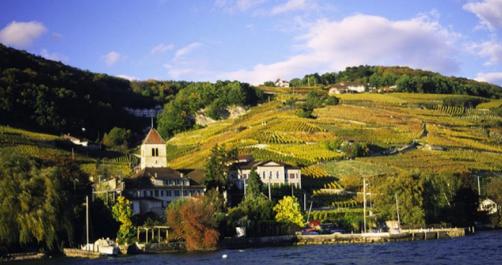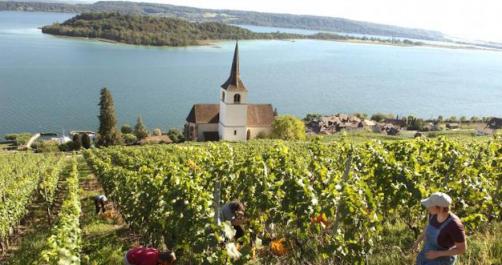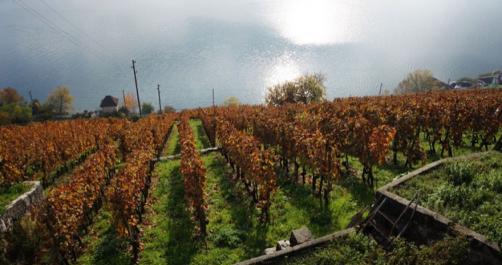A hidden gem, the Bielersee vineyards
The Bielersee vineyards, Switzerland, a hidden gem
By Laurent Probst | October 27, 2014
The Bielersee region includes 80 wineries spread over 3 main areas; the overall surface is only 220 hectares (550 acres).
We went to visit three of them, all recently recognised in the recent edition of the Top 100 best wineries of Switzerland by Gault & Millau. We met Sabine Steiner in the Schernelz Village, Adrian Klötzli (rookie of the year) and Martin Hubacher. The two later are located in Twann. They had us taste their wines and discuss their careers with all the flame and wisdom that characterizes them, and that all in perfect French (although the region is German Swiss, but on the border).
Schernelz and Twann are located in the largest of the three areas of Bielersee wine region, which is situated on the north shore of the lake, in the foothills of the Jura. A region that starts in Neuveville for its western part, and continues facing the lake towards the city of Biel, ten kilometres to the east. The area can be significantly steep in places It is a beautiful gem that we invite you to discover. What a pleasure to see the hillside vineyards diving into the lake and then observe the panorama before our eyes, from St. Peter’s peninsula, to the highest Alpine peaks behind Bern and Fribourg.
The second wine area is located southeast of the lake, and includes the villages of Erlach, Gampelen and Ins. The third, more confidential, is located on St. Peter’s peninsula, somehow in the middle of the lake. It is a nice walk and the place is known having hosted the philosopher Jean-Jacques Rousseau.
During our visits, the three producers have told us about the reshuffle and consolidation of the vineyards that was undertaken in the last decade. They moved from 50 or 40 areas to only 5 or 6 on a surface of six hectares (15 acres); now they are down to half dozen, and enjoy the benefits of these changes. It also led to the professionalization of smaller wineries.
But let us leave these considerations aside and let's look at the character of the wine region. The soil of the main area is similar to those of the neighbouring region of Neuchâtel, where limestone dominates; it is both very close and very different.
Pinot noir and chasselas are the dominant grapes. Pinot noir wines are grown either in metal or timber tanks, some are aged in oak barrels.
Known specialties like chardonnay, pinot gris, sauvignon blanc, pinot blanc, gewurztraminer and riesling-sylvaner (also known as Muller-Thurgau) are present, but one will also find varieties lesser known abroad and created by the Changins Swiss school of viticulture such as gamaret, garanoir and diolinoir.
It is interesting to meet other varieties since the AOC for the Bielersee is flexible and accepts a large variety of grapes such as malbec, syrah or St-Laurent… The list is long: almost forty varieties! This diversity makes the Bielersee region a true ampelographic test bed. A situation created as much by human curiosity than by climate change in recent decades. Some producers, particularly the best, are becoming cautious and tend to consolidate.
Among the wines we recommend you should discover, apart from the specialties, the pinot noirs have reached beautiful levels. They alone demonstrate the expertise of the winemakers. One should also try the sparkling wines which demonstrated very fine qualities during blind tastings.
You should also know that the wine library "Viniterra" in the village of Twann (or Douanne since all villages in the area have a French name in addition to their German name), offers to discover up to 300 wine and vintages from sixty producers.
To get to the vineyards
Travel to Neuchâtel or Biel, then take a local train up to Ligerz, Twann or Tüscherz. From Biel it is also possible to take a boat to Ligerz, Twann or Tucherz. A cable train runs through the vineyards between Ligerz, Schernelz-village and Prêles. It will take you effortlessly on top of the Bielersee hills.
See all or parts of the wine country trail
The trail runs along the sunny left bank of the Bielersee, it is probably one of the most beautiful paths in Switzerland (4 hrs walk). In 1977, this area was listed as a nationally significant landscape.
The trail can be reached from any port or train station between Biel and La Neuveville. A particular section, between Twann and Ligerz (1 hour walk), was developed with signage and explanations to educate passers by about the work on the vines. When arriving in Ligerz (Gléresse you may visit the museum of viticulture.

